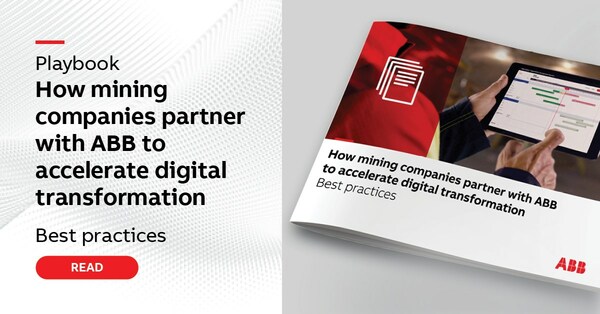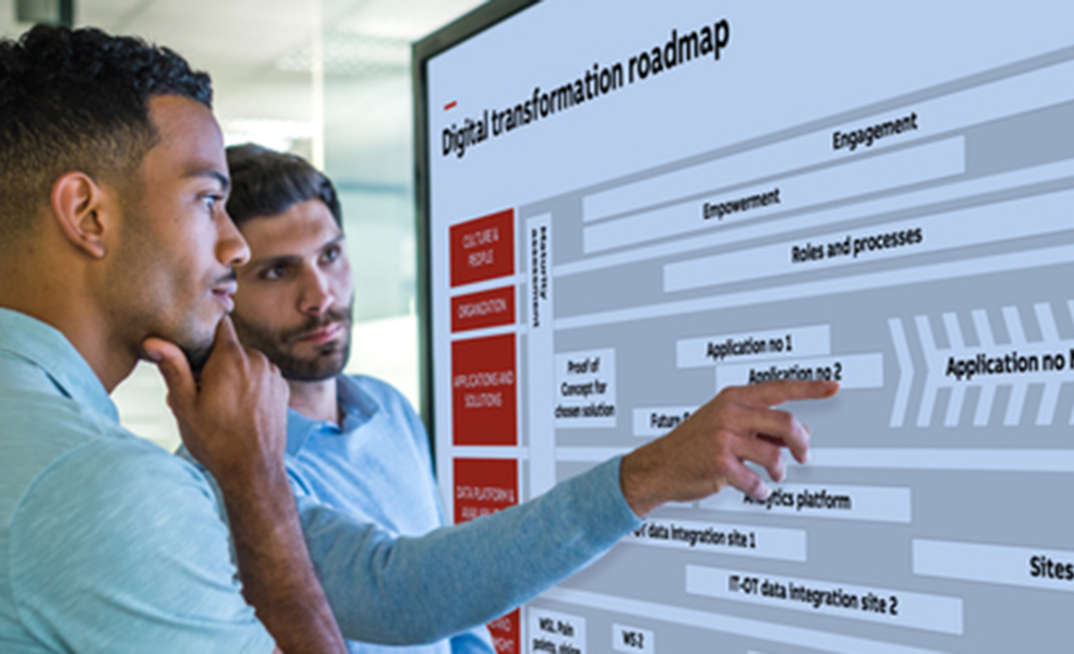To help companies navigate the complex landscape and pursue programmes that deliver on value, ABB has developed a digitalisation roadmap that rests on five areas, or "value pillars".
ABB aims to leverage these pillars alongside its strengths as a provider of physical and digital solutions - the company works closely with everything from mining robots and trolley-assist systems to AI and augmented reality. ABB´s vision is that automation, digitalisation and electrification must go hand in hand for real digital transformation, and deliver on the values of sustainable and efficient mining operations.
The company said that it chose the five solution areas - sustainability, asset performance (AI/ML), process performance, operational excellence and a connected workforce - because together they can be used to provide demonstratable evidence that digital transformation strategies are working.
There is also a horizontal layer, which is cyber security and is critical across the five pillars. For ABB, it is a significant area of focus, but it is something that the company expects to be there as a standard.

Sanjit Shewale, Global Head of Digital, Process Industries
Sanjit Shewale, vice president and global head of Digital, Process Industries Division at ABB, explained that while the five areas are based on both long-held customer needs and the company's solutions and domain expertise, they also reflect massive changes in mining in recent years.
"If you look at process performance and operational excellence, these aren't new concepts, but asset performance management has become much stronger because of artificial intelligence, machine learning and other advances that have evolved significantly over the past 20 years. There were assetmanagement solutions 30 years ago, but they can't be compared with today's - with predictive analytics for improving reliability and uptime," he said.
Sustainability and success
Shewale explained that sustainability was chosen not just for the obvious reasons, such as energy management and emissions or water management.
"In our industry, the retiring workforce raises a serious issue in terms of sustainability. How can we transfer the knowledge of people that have been in the industry for 20 or 30 years to Generation Z or Millennials?
"We need to be able to fast track their learning, because that all translates into the safety of operating equipment and learning about the key processes."
Another important concept of digitalisation is to promote greater collaboration among different areas of the value chain. The value pillars must all be connected to maximise plant benefits.
As an example, predictive maintenance has a solid connection to the sustainability pillar and production. A reliability engineer, who needs to work closely with the production manager, may sometimes face a decision that involves running a piece of equipment close to a failure curve, even though that could result in higher energy consumption.
In the end, for a holistic optimisation of the value chain, digital needs to serve as a basis for collaborative working, instead of an old siloed way of operating.

Marcos Hillal, Global Product Line Manager, Automation & Digital
Marcos Hillal, global product line manager for automation and digital at ABB, added that integration was a critical part of progress in digitalisation.
"With data, it is essential to remember that if we can't measure, we can't control. Advanced algorithms can't make the right predictions if the basics aren't right."
"For a complex and important project such as cost reduction, we can dig into millions of data points, but it still needs to be correctly processed, ingested and managed to extract the right value from operations."
"Most of the time spent in data-driven projects is still around preparing the data correctly, cleaning up outliers. That's a big hurdle, and mining is no different.
"Correct usage of the technology associated with the right domain expertise, those are the crucial factors to enable data integration and the five value pillars.
Asset models
A nuanced and streamlined integration of data then enables digitalisation to bring more value by ABB on pillars for stronger digitalisation platforms 22 2 Review Established 1909 2022 edition preventing downtime for today's increasingly complex and costly assets.
"Like other industries, there're a lot of existing or legacy solutions in mining," Shewale said. "Most of them have asset data - whether from enterprise-management systems or newer ‘Internet of Things' sensors.
"Even discounting the newer, connected assets, we can now bring in data from everywhere, from all assets, and, importantly, take a platform-based approach and use a standard interface. Crucially, this allows us to get the data in one common area."
Once this data is in a common area, asset models can be created.
"In mining, we have unique assets and unique processes, which we can help define the asset models and algorithms. As we develop these, we will start to see more predictive maintenance and prescriptive analytics being applied to the industry.
"If I go back 10 years, it was still disparate systems. We couldn't integrate assets into one common platform. Now, with the added horsepower of leveraging the cloud, or edge analytics, that changes everything.
"What's more important, it's not doing predictive maintenance just on one asset, or process area, there are many assets in the value chain of production, and having a holistic and integrated approach is what will bring the value of the digitalisation."
An important tool the company uses as part of its transformation programme is its Digital Maturity Assessment. This online tool uses on-site surveys and interviews to evaluate a customer's existing practices, including its digital and IT/OT capabilities.
The tool provides a report pinpointing where the company is on the digital transformation journey with respect to industry best practices and its strategy.
Hillal said the tool is essential because it helps miners know their digital transformation "definitely is not going to happen overnight".
This is really a ‘journey' and it's not an easy journey to take, especially when we talk about brownfield sites. You may have to convert how you operate the plant, and sometimes it takes years to achieve this. The first aspect that we have to take care of is to understand the company's digital-transformation goals.
"In ABB we developed a structured approach to digital transformation. That starts by creating, together with the customer, the end goals for the programme. We have to understand where the gaps are, the critical pain points to the operations, and prioritise the plan. Near the beginning, we have to define the quick wins."
Change management
This incremental, structured and layered process is critical in terms of developing an internal readiness to start the digital transformation, particularly in the area of change management.
"When people started talking about digitalisation in 2014, all the companies thought ‘yes, let's do this'," said Shewale. "So, they built digital teams, hired CTOs (chief technology officers), and it was seen as a project.
"But the thing is, that this is continuous. It's a constant digital journey. It's always evolving.
"With change management, it is good to start with what are the initial things, as every customer has different requirements. What is their low-hanging fruit? What do they start with that's small, because that's the most important thing?
"The biggest mistake you can make is getting into a very complicated digital-transformation plan's initial phase, and then the project fails - companies can waste over a year if this happens.
"For change management, it is far better to take smallsteps and get the quick wins to show use cases. Once you're able to do that, the change management becomes a bit easier, because people are recognising that this is something of value.
"There must be a vision that is communicated clearly to the entire company; ifsomebody is put in a role that's trying to be an evangelist, it's extremely difficult. Unless the whole organisation is on board, you will never get change management right".

To find out more, read ABB's playbook for digitalisation at scale: https://campaign.abb.com/mining-automation-ebook-2
ABOUT THIS COMPANY
ABB
ABB brings equipment, systems and people together to make mining operations safer and achieve a more profitable, sustainable future. ABB’s unique expertise is in seamlessly integrating electrical, automation and digital applications into engineered solutions to help mining customers optimize their operations and meet the challenges of future mining.
CONTACT DETAILS:
- Website: new.abb.com/mining
- Email: minerals@ch.abb.com


























